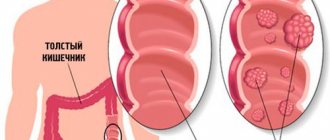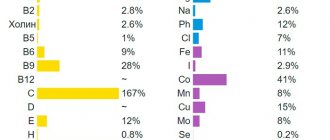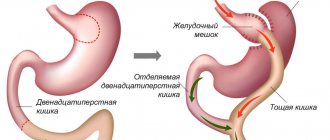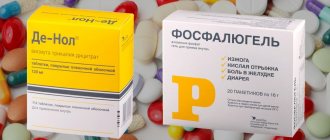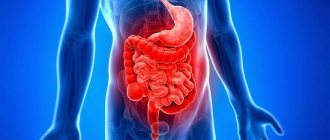The most common causes of gastritis are Helicobacter pylori infection, stress and poor diet. But a form such as autoimmune gastritis is much less common.
With this type of disease, a malfunction occurs, as a result of which the immune system perceives the cells of the epithelial layer lining the stomach from the inside as foreign and destroys them. As a result, large areas of the mucous membrane atrophy and the digestion process cannot proceed normally.
Causes
The causes of autoimmune gastritis have not yet been precisely established, however, factors that contribute to the development of the disease are known, these are:
- Heredity. If one of your relatives has this disease, the risk increases significantly.
- Severe stress. Nervous tension can cause a malfunction of the immune system.
- Mechanical or chemical damage to the gastric mucosa. The development of the disease can begin after injury or poisoning with any caustic substance.
In any case, the root cause of this serious disease is a failure of the protective function (immunity). Under the influence of negative factors, antibodies begin to be produced directed against healthy cells of the epithelial layer lining the digestive organs.
The result of cell destruction is gradually developing atrophy of the inner gastric lining, the inflammatory process spreads, and the production of hydrochloric acid and digestive enzymes is greatly reduced.
Advice! Gastritis is a “companion” of other autoimmune diseases, in particular thyroiditis.
The main causes of autoimmune processes in the body
? As numerous studies show, autoimmune gastritis does not exceed 1% of all patients. The exact causes of this type of disease have not been fully established. But most experts agree that the immediate root cause of gastritis is genetic predisposition.
Disorders of autoimmune processes in the body can provoke the development of the disease. As a result of this kind of disorder, personal immunity begins to fight the stomach tissues, considering them as foreign components. As a result of such actions, a persistent inflammatory process occurs, which leads to the stomach losing its ability to function normally.
The formation of such processes in the body can be facilitated by mechanical injury to the gastric mucosa. Such damage can be caused by hard food and the Helicobacter bacteria. With insufficient production of type “A” immunoglobulin, antibodies are formed, as a result, instead of healing the damaged mucosa, the body’s defense system begins to attack the parietal cells.
At this time, the formation of antibodies to the Castle factor occurs, which leads to a disruption in the absorption of vitamin B 12. As a rule, the formed antibodies have a detrimental effect on the mucous walls of the organ, which contributes to enzyme deficiency. Because the glands, whose main task is to produce enzymes, are suppressed and atrophy. In most cases, autoimmune processes occur directly in the body and bottom of the organ.
Symptoms
With autoimmune gastritis, the symptoms differ little from the symptoms of gastritis with low acidity. Main features:
- frequent nausea, often turning into vomiting;
- diarrhea;
- unpleasant taste of metal in the mouth;
- “rumbling” in the stomach, bloating;
- lack of appetite;
- abdominal pain that occurs after eating.
Symptoms appear gradually as the disease progresses. Some signs may be absent or appear much later, several years after the onset of the disease.
Special symptoms of autoimmune gastritis, uncharacteristic of another type of disease, are increased nervousness of patients. This is due to the fact that with changes in the stomach, the body stops absorbing vitamin B12 and other vitamins from this group.
The consequence of this is increased emotionality, memory impairment, and constant tension. The disease also affects the appearance of patients. Due to the fact that the body lacks vitamins and other nutrients, the following symptoms are observed:
- pale skin;
- brittle nails;
- tooth decay;
- baldness.
The disease should not be neglected, as it will only progress if left untreated. It is necessary to seek medical help when the first signs of the disease appear.
Symptoms
The initial manifestations of the clinical picture may only indicate a minor disorder in the gastrointestinal tract. Changes in symptoms occur quite quickly. Further, autoimmune gastritis manifests itself in the form of the following symptoms:
Symptoms of autoimmune gastritis
- feeling of heaviness and fullness in the stomach;
- nausea, sometimes vomiting;
- unstable stool;
- heartburn and belching with a rotten smell;
- increased gas formation.
Many patients experience bad breath due to poor digestion. The food consumed is not digested and begins to rot.
In more complex cases, the basic clinical picture may be supplemented by the following signs:
- white coating on the tongue;
- increased sweating, especially at night;
- sleep disturbance – the patient either does not get enough sleep or cannot sleep at all;
- lethargy, irritability;
- low blood pressure;
- dry skin.
This condition of the patient requires immediate medical attention, as the condition can worsen at any time.
Due to the fact that the clinical picture does not give a clear picture of the disease, independently comparing symptoms and treatment is strongly not recommended. The diagnosis can only be made by a doctor after diagnostic procedures.
Forms of autoimmune gastritis
There are two forms of autoimmune gastritis; the type of disease is diagnosed during the examination. Both forms can lead to extremely serious health consequences.
Atrophic
With autoimmune atrophic gastritis, immune cells actively destroy cells of the epithelial layer, which causes tissue atrophy. Resulting in:
- normal digestion becomes impossible;
- a sufficient amount of hydrochloric acid ceases to be produced;
- gastrointestinal motility is impaired.
Advice! This is a very dangerous condition; when suffering from autoimmune gastritis of the atrophic form, a person feels worse every day, and the disease itself often turns into a malignant form.
Chronic
Cases of autoimmune chronic gastritis are more common than atrophic gastritis. The disease is characterized by an undulating course, when periods of improvement are followed by deterioration.
With chronic autoimmune gastritis, persistent vitamin deficiency develops. In this form, the inflammatory process is localized in a specific area of the organ, without affecting others. With a chronic course, complications often develop, including the growth of malignant tumors.
How to treat autoimmune atrophic gastritis
Autoimmune gastritis is a chronic inflammatory process affecting the mucous structures of the stomach. This condition occurs due to malfunctions of the immune system, in which the body begins to produce antibodies to its own stomach cells. This pathology is extremely rare - according to statistics, only 10% of all people with various forms of gastritis suffer from it.
The exact causes of this disease have not yet been established, but most experts are inclined to believe that the main factor in the formation of autoimmune gastritis is genetic predisposition.
For the prevention and treatment of gastritis and peptic ulcers, our readers recommend a proven gastric collection
from gastrointestinal diseases. Read the doctors' opinions. >>
There are two types of autoimmune gastritis:
- Autoimmune atrophic gastritis. It is characterized by the fact that the human immune system begins to destroy its own cells in the walls of the stomach, which leads to a decrease in the acidity of gastric juice, gland dysfunction, impaired motility and a deterioration in the digestion of food. This type of gastritis can provoke the formation of a malignant tumor.
- Autoimmune chronic gastritis. This disease is characterized by the production of specific antibodies to gastromucoprotein, a protein that absorbs vitamin B12 from food and creates stomach protection. When antibodies begin to destroy this protein, the mucous membranes of the stomach gradually atrophy. Complications of this form of gastritis can be anemia, polyhypovitaminosis, and adenocarcinoma.
The impetus for the development of autoimmune gastritis can be:
- bad habits;
- frequent overeating;
- eating cold, hot, coarse or spicy foods.
Autoimmune gastritis usually has a chronic form, and it is often accompanied by disorders of the endocrine system, usually autoimmune thyroiditis.
Almost all types of gastritis make themselves felt after eating. Autoimmune gastritis is no exception. Every meal for people with this disease results in many problems, including:
- feeling of fullness, heaviness in the abdomen;
- stomach pain;
- heartburn;
- belching air with a rotten smell;
- nausea, often causing vomiting;
- increased gas formation;
- rumbling, gurgling in the stomach;
- disgusting taste in the mouth;
- constipation or diarrhea.
Most patients have bad breath. This is due to the deterioration of food digestion processes, as a result of which the food bolus remains in the stomach for a long time and gradually begins to rot.
In addition to symptoms associated with food intake, autoimmune gastritis can also manifest as a general deterioration in the body’s condition. Phenomena such as:
- sluggish appetite, weight loss;
- dizziness, weakness;
- heavy sweating, especially after eating;
- increased irritability;
- low blood pressure;
- the appearance of pigment spots on the skin, or pallor of the skin;
- headache;
- sleep disturbance;
- coating on the tongue;
- vitamin deficiency, manifested by dry skin, fatigue, brittle nails, hair loss.
Lack of vitamins with this gastritis can also manifest itself in a number of specific symptoms. For example, vision may be impaired by vitamin A deficiency; frequent diarrhea and dermatitis occur due to a lack of vitamin PP; gums bleed when there is little vitamin C; If the body does not have enough vitamin B2, wounds and “stubs” may appear in the corners of the mouth.
Autoimmune gastritis, the symptoms of which can be very diverse, often leads to the development of serious complications, so treatment should not be delayed. If the slightest signs of illness appear, you should see a doctor and undergo appropriate examinations.
It will not be difficult for a qualified specialist to identify gastritis based on clinical symptoms, but to clarify the diagnosis and confirm the autoimmune nature of the origin of gastritis, a number of examinations are required:
- Fibrogastroduodenoscopy with biopsy. Allows you to assess the condition of the gastric mucosa. If gastritis is at an early stage, the mucous membrane will be edematous, swollen, ulcers and erosive processes may be observed. If gastritis is advanced, the mucosa will be pale, atrophic, with deformed epithelial structures. A biopsy often reveals developing cancer cells.
- Probing of the stomach. It is necessary to determine the acidity of gastric juice, as well as the content of Helicobacter.
- Blood serum analysis. The purpose of this procedure is to determine gastrin levels. If it is elevated, this may indicate incipient malignant tumors of the stomach.
- Immunological blood test. Required to identify autoimmune disorders such as rheumatoid polyarthritis, autoimmune thyroiditis and others. In addition, in patients with autoimmune gastritis, Epstein-Barr virus, herpes viral infection, and iron deficiency anemia can often be detected. The Epstein-Barr virus is dangerous because it can lead to the formation of tumors of the nasopharynx, stomach, duodenum, and other organs.
- PCR. In the process of polymerase chain reaction research, the constituent components of DNA viruses, as well as other microorganisms present in the patient’s tissues, are studied.
- Ultrasound of organs located in the abdominal cavity. Most patients experience enlargement and deformation of the liver. In some cases, the spleen and lymph nodes may become enlarged.
All these diagnostic operations make it possible to accurately determine the form of the disease, the patient’s predisposition to the development of complications and determine the required therapeutic approach.
Treatment of autoimmune gastritis should be comprehensive. Therapy is usually aimed at reducing inflammation, relieving acute symptoms, normalizing the functioning of internal organs, eliminating disorders, and restoring the secretory function of the stomach.
The most commonly prescribed medications are:
- For severe stomach pain, painkillers and chonolitics are used: No-spa, Mezim, Gastrotsepin, Platyfillin, Metacin.
- To relieve spasms: Papaverine, Halidor, Buscopan, Drotaverine.
- Drugs to increase gastric motility: Motilium, Metacin, Famotidine, Cerucal.
- Preparations for replenishing hydrochloric acid deficiency: Limontar, Pentagastrin, Abomin, Pepsidil, Pankurmen, Panzinorm, natural gastric juice.
- Preparations for the restoration of the gastric mucosa: Venter, bismuth preparations, Plntaglucid.
- To improve the condition of the stomach, multivitamins, folic acid, and means for normalizing microflora are used.
- If acidity is low, herbal medicine using sea buckthorn oil, as well as infusions of plantain, fennel, parsley, mint, oregano and thyme can have a good effect.
A special diet is an essential part of the treatment of autoimmune gastritis. The diet is selected in such a way as to remove excess load from the gastrointestinal tract. You will need to exclude rough foods, too cold and hot from your diet. Spicy, alcohol-containing and salty dishes will need to be limited to a minimum. It is necessary to give preference to soft and puree foods - soups, porridges, broths. In addition, successful treatment involves completely giving up bad habits and minimizing stressful situations.
source
Autoimmune gastritis is a rare inflammatory disease in which the body itself acts destructively on the mucous tissue of the stomach. This condition is associated with malfunctions of the immune system. Autoimmune disease does not depend on the gender or age of the patient. This form of gastritis is diagnosed in approximately 1 case out of 10.
The exact etiology of this autoimmune disease has not been determined. Official medicine believes that chronic autoimmune gastritis has a genetic predisposition. The disease may be accompanied by other disorders of the gastrointestinal tract and endocrine system.
Provoking factors may be:
- weakened immunity;
- history of inflammatory and infectious diseases;
- stress;
- unhealthy diet;
- intemperance in drinking alcohol;
- smoking.
For your information! In the absence of individual predisposition, these circumstances in themselves cannot serve as the cause of the disease.
There are two forms of the disease. Both can lead to serious complications.
The disease autoimmune atrophic gastritis is characterized by this feature - the body itself harms the cells of the stomach.
This reaction of one’s own immunity leads to negative consequences:
- The gastrointestinal tract does not cope with its work;
- gastric motility is impaired;
- acidity decreases;
- The process of digesting food significantly worsens.
For your information! This type of autoimmune gastritis is highly likely to lead to cancer.
When the body itself produces antibodies to the gastromucoprotein protein, gastric atrophy occurs. This protein is involved in the successful absorption and processing of vitamin B12 from food.
Serious complications may develop as a result of the disease:
- pathological deficiency of vitamins;
- anemia;
- oncological disease.
For your information! The symptoms of the initial stage and during the exacerbation period are different.
Almost all types of gastritis manifest themselves after eating. After eating food, the patient at the initial stage may be bothered by the following symptoms from the digestive system:
- diarrhea or constipation;
- rotten taste in the mouth;
- gas formation;
- nausea;
- belching;
- frequent heartburn;
- discomfort and pain in the stomach.
These manifestations are associated with stagnation of food in the gastrointestinal tract due to poor digestion of food. In addition to these symptoms, at the stage of exacerbation, a patient with autoimmune gastritis may additionally be bothered by general ailments:
- sleep problems;
- headache;
- decreased blood pressure;
- unexplained irritability;
- weakness;
- dizziness;
- sudden weight loss;
- poor appetite;
- sweating, which increases after eating;
- dry skin, paleness;
- the appearance of pigmented spots;
- coating on the tongue.
An insufficient amount of absorbed vitamins during autoimmune gastritis gives rise to a deterioration in the functioning of various body systems, leading, for example, to dermatitis and decreased vision.
If you suspect a gastrointestinal disease, the patient should consult a doctor. Diagnosis of autoimmune gastritis is determined by the patient’s complaints and the manifestation of symptoms. To confirm the diagnosis, the patient is scheduled to undergo an examination.
This examination method makes it possible to determine various types of deformations and even slight enlargement of some organs. The specialist will definitely examine the condition of the lymph nodes, liver and spleen.
PCR may be prescribed as an additional examination method. This study makes it possible to study the patient’s tissues for the presence of microorganisms that are components of DNA viruses.
Autoimmune disorders are detected using an immunological blood test. It allows you to identify many disorders and confirm the diagnosis in patients with autoimmune gastritis.
This indicator is determined by blood serum analysis. An increase in the indicator is a signal that malignant degeneration of stomach tissue is possible.
In order to exclude the presence of Helicobacter and to determine the level of acidity, the patient undergoes gastric intubation. This is a necessary, albeit unpleasant, procedure.
The event is carried out to determine the condition of the gastric mucosa. Depending on the stage of the disease, the doctor notes the presence of swelling, erosions, the color of the mucous membrane, and the presence of deformities. A biopsy allows you to recognize cancer.
Completing diagnostic measures allows you to clarify the diagnosis, identify all the features of the condition and outline a treatment strategy for the disease.
Treatment of autoimmune gastritis must be comprehensive, aimed at reducing inflammation, restoring secretion, normalizing the functioning of the gastrointestinal tract, and preventing exacerbations.
Modern methods of treating atrophic gastritis include medications and dietary nutrition . Following a diet allows you to keep your stomach condition under control and prevent an exacerbation stage. Modern treatment methods make it possible to eliminate symptoms within a week. A stable improvement in well-being occurs after 15-20 days.
These drugs are prescribed for significant stomach pain. Most often these are the following drugs:
Medicines in this group relieve pain caused by spasms. These include:
Special means are used to treat the stomach:
- restoration of the mucous membrane is facilitated by taking, for example, Venter;
- Abomin, Limontar, Panzinorm influence the level of hydrochloric acid;
- improve gastric perilstatics - Cerucal, Metacin and Motilium.
Patients with autoimmune gastritis are also prescribed a comprehensive intake of multivitamin preparations, agents that restore intestinal microflora, and folic acid. Traditional medicine based on herbal components can be used.
With low acidity, gastritis can be treated using tinctures in therapy:
Diet is one of the components of treatment that should not be neglected. The main approach to choosing dishes: they should not create increased stress on the gastrointestinal tract.
To do this, remove from the patient’s menu:
- cold, hot and rough food;
- spicy and fatty foods;
- fresh baked goods, sweets;
- hard-to-digest and rough food, including smoked meats.
Advice! It is advisable to give up bad habits.
Preference should be given to food with a soft consistency and warm temperature. Steamed, boiled and baked dishes will be best digested.
All these requirements are met:
To stabilize the condition, it is important to follow a meal schedule. Eat small portions 5-6 times a day.
Complete cure of autoimmune gastritis is impossible due to the specificity of the disease and unknown origin, especially with atrophy of the gastric mucosa . In this regard, it is extremely important for a favorable prognosis to follow the instructions of the attending physician, follow the specified treatment regimen, follow a diet and regularly monitor the condition.
The information on our website is provided by qualified doctors and is for informational purposes only. Don't self-medicate! Be sure to consult a specialist!
Author: Rumyantsev V. G. Experience 34 years.
Gastroenterologist, professor, doctor of medical sciences. Prescribes diagnostics and carries out treatment. Expert of the group for the study of inflammatory diseases. Author of more than 300 scientific papers.
source
Chronic atrophic gastritis (CAG) is one of the forms of chronic gastritis, a feature of which is atrophy of the gastric mucosa (GM), accompanied by dysfunction of the glandular apparatus; the second most important link in the pathogenesis is a violation of mucosal regeneration with metaplasia (degeneration of the gastric epithelium into the intestinal epithelium).
Symptoms of the disease in adults depend on the location of the process, its prevalence, and etiology. Often the signs of the disease are mild - belching, sometimes nausea, discomfort in the mouth, a feeling of heaviness in the stomach. The diagnosis is made on the basis of FGDS with biopsy, pH-metry of the stomach, and detection of H. pylori. Treatment includes: replacement therapy, vitamin B₁₂, anti-Helicobacter therapy.
There are focal and diffuse CAH. In the focal form, the mucosa has a mosaic appearance - areas of atrophied tissue alternate with areas of tissue without signs of atrophy, thus, a mixed nature of the pathology is observed. With diffuse CAH, the entire gastric mucosa is involved in the process.
Atrophic gastritis is an inflammatory disease of the stomach, characterized by atrophy of the mucous membrane, death of the glandular apparatus of the stomach, and disruption of regeneration processes. The process, without exacerbation, occurs against the background of a moderately pronounced inflammatory reaction. CAH is a morphological concept; to verify the diagnosis, it is necessary to perform an FGDS with a biopsy.
The endoscopic picture is quite typical: the gastric epithelium is flattened, in places replaced by intestinal epithelium with typical enterocytes and goblet cells. In the surviving parietal cells (stomach cells, their function is the synthesis of hydrochloric acid), signs of atrophy are detected (vacuolization of the cytoplasm, its rarefaction, reduction of mitochondrial cristae).
Metaplasia that accompanies CAH, from the point of view of oncologists, is a harmless process, simply one type of differentiated tissue is replaced by differentiated tissue of another type. However, it must be remembered that this replacement occurs in an anatomical area that is not adapted for the normal development of this new tissue. As a result, dysplasia occurs (the development of new tissue cells and their differentiation are disrupted, followed by disruption of tissue architectonics). Dysplasia goes through several stages, resulting in the formation of undifferentiated small cells capable of rapid reproduction. Atrophic gastritis turns into cancer.
The likelihood of such a transition is not currently disputed by any scientist. A huge amount of work has been done, many scientific conferences have been held on the topic “Atrophic gastritis and cancer.” Statistics say that 15% of all cases of CAH develop into cancer. The importance of these findings can hardly be overestimated; doctors have received a scientifically based basis for the early detection of stomach cancer.
The two most significant causes of pathology are generally accepted:
- H. pylori infection;
- autoimmune processes.
When infected with H. pylori, atrophic processes in the stomach develop as a result of long-term chronic inflammation. H. pylori first settles in the antrum, then in the body of the stomach, and then throughout the entire mucous membrane of the organ, initially causing inflammation and then atrophy of the gastric mucosa.
With autoimmune gastritis, the disease develops very quickly; autoimmune antibodies are formed not just to the cells of the mucous membrane, but also to their organelles and even individual protein molecules. The reasons for the appearance of antibodies are not clear, but it is known that in order to trigger the autoimmune cascade, the antibody titer must reach a certain critical value, but various factors can affect the speed of this process:
- genetic characteristics;
- somatic diseases;
- hypovitaminosis;
- bad habits;
- starvation;
- eating disorders;
- chronic infections.
Focal atrophic gastritis is a form of CAH when not the entire coolant is affected by the atrophic process, but only its individual segments.
Between the foci of atrophy there are areas of hyperplastic epithelium with preserved glandular apparatus. These areas of the mucosa secrete an increased amount of hydrochloric acid, trying to compensate for the function of the lost glands in atrophic foci. Depending on whether areas with atrophy or without atrophy (with preserved function) predominate, a hypoacid or hyperacid state occurs (low or high acidity of gastric juice).
OAS develops slowly, symptoms are mild. The patient is concerned about:
- nausea;
- belching;
- lack of appetite;
- flatulence, rumbling in the stomach;
- unstable chair.
Menetrier's disease, atrophic hyperplastic gastritis, stands apart. The etiology of the disease is unknown. The disease has diffuse and focal forms. The focus of atrophic hyperplastic gastritis is a proliferation of epithelial folds. With FGDS, intestinal metaplasia, proliferation and hypertrophy of the mucous glands are observed in combination with almost complete atrophy of the main acid-producing glands. At the onset of the disease, a hyperacid state is observed, followed by achylia (lack of pepsin and hydrochloric acid).
Symptoms of focal atrophic gastritis:
- stomach ache;
- feeling of fullness in the stomach;
- vomit;
- diarrhea;
- lack of appetite.
The main drugs for the treatment of chronic atrophic gastritis can be divided depending on the acidity of the gastric juice.
For the treatment of chronic gastritis with focal atrophy, occurring against the background of a hyperacid state, with and without erosions, the following drug treatment is used:
- Antibiotics: Amoxicillin, Clarithromycin, Arvicin, Kriksan, Panclave. Any treatment regimen for the eradication of Helicobacter pylori includes at least two drugs with antibacterial action. After a course of antibacterial drugs, probiotics (Lactobacterin, Biobakton) and prebiotics (Duphalac) are prescribed.
- To reduce the concentration of H+ ions, proton pump inhibitors (Omeprazole, Pariet, Nolpaza), IGR (Ranitidine, Famotidine), antacids (Almagel A, Phosphalugel) are prescribed.
- Cytoprotectors – De-nol, Vikalin, Venter, Rebagit.
- To eliminate dyspeptic disorders, prokinetics are used - Trimedat, Domperidone, Cerucal.
- In case of severe pain, antispasmodics (Papaverine, No-shpa) or M-cholinergic drugs (Platifillin, Metacin), Befungin are prescribed.
For focal atrophic gastritis with reduced secretory function, the following drug treatment is used:
- In case of insufficient acid formation, replacement therapy is prescribed, which the patient will have to take for the rest of his life (Acidin-pepsin, Abomin Pepsidil).
- If enzymatic activity is impaired, enzyme preparations (Creon, Pangrol) are prescribed.
- Preparations that restore mucous membranes (Solcoseryl, Riboxin, Aloe vera, Actovegin)
- Vitamin B₁₂.
- Plantaglucide is used for secretory stimulation.
Chronic diffuse atrophic gastritis is a form of chronic inflammation in which the glandular apparatus of the stomach is affected, and the entire mucous membrane of the organ or most of it is involved in the process.
It should be remembered that diffuse atrophic gastritis is a continuous, pathological process, which means that any division into stages and classification is very conditional. The following stages of the process are distinguished:
- The superficial form of atrophic gastritis is the 1st stage of the disease, when the pathological process affects only the biochemistry of the cell, without externally manifesting itself.
- Moderate form of hypertension (stage 2) - although biochemical changes can be detected throughout the entire mucosa, only a part of the cells of the glandular apparatus undergo atrophic changes.
- Diffuse atrophic gastritis (stage 3) is a severe form of the disease. The pathological process involves almost the entire coolant - the fundus, body and antrum. The secretory function of the stomach decreases sharply. Insufficiency of the cardia occurs, the functioning of the pyloric sphincter is disrupted with the development of reflux gastritis. If the disease is not treated, the functioning of the entire digestive tract is disrupted with symptoms of bulbitis, duodenitis, and cholecystitis. With further development of intestinal metaplasia, the occurrence of cancer is very likely.
Hyperplastic gastritis is a disease of unknown etiology, accompanied by hypertrophy of the coolant, while the glandular apparatus undergoes atrophy. This form of the disease is dangerous because polyps appear on the surface of the thickened folds of the stomach, the likelihood of malignancy increases sharply, in addition, the folds are often covered with erosions with a hemorrhagic component. In both of these cases, surgical treatment is required. If bleeding recurs, the stomach is completely removed.
Diffuse atrophic gastritis is manifested by nonspecific symptoms:
- white coating on the tongue;
- dryness and unpleasant sensations in the mouth;
- abdominal discomfort;
- belching;
- unstable stool (constipation alternates with diarrhea);
- loss of appetite.
Treatment of diffuse atrophic disease includes the following groups of drugs:
- Replacement therapy drugs – Acidin-pepsin, Abomin.
- Agents that stimulate the acid-producing function of the parietal cells of the stomach: Mineral waters (Essentuki, Morshinskaya, Narzan);
- Rose hip decoction;
- Plantaglucide;
- Limontar.
Autoimmune atrophic gastritis is an atrophic process in the gastric mucosa caused by antibodies synthesized by the body itself. The etiology of the disease is not fully understood.
In autoimmune atrophic gastritis, the symptoms of the disease reflect the result of the action of autoantibodies on the gastric mucosa - these are the symptoms of diffuse atrophic gastritis:
- feeling of fullness and discomfort in the abdomen;
- nausea, belching,
- white coating on tongue
- flatulence, rumbling in the stomach,
- unstable chair.
It is currently impossible to eliminate autoimmune lesions of the mucous membrane. Steroid hormones are prescribed when gastritis is accompanied by pernicious anemia. In all other cases, the side effects of steroids are greater than the effect of them.
Treatment tactics and medications are the same as for diffuse atrophic gastritis.
Atrophic gastritis with low acidity occurs over a sufficiently long period, when the number of acid-producing cells decreases to a critical level. In this case, the digestive processes are disrupted, and symptoms of the disease appear:
- feeling of fullness and heaviness in the stomach;
- decreased appetite;
- painful belching;
- bitterness in the mouth;
- hypersalivation.
Diagnostics includes: FGS study, pH measurement of gastric juice, detection of Helicobacter pylori infection.
- replacement therapy (Pepsidil, Abomin)
- enzyme preparations (Creon, Festal);
- vitamin therapy (vitamin B₁₂);
- secretory stimulation (Plantaglucid).
Atrophic gastritis with high acidity occurs in the first stages of the atrophic process, when small areas of mucosal atrophy are surrounded by normal tissue with preserved glandular apparatus. In response to a decrease in the number of cells capable of secretion, the secretion of healthy cells increases. At the very beginning, this is a compensatory mechanism, which quickly turns into a pathological one that needs to be treated. An increased amount of acid acts on the gastric mucosa, causing the formation of erosions and even ulcerative changes.
Signs of a hyperacid state:
- constant feeling of discomfort in the stomach;
- moderate abdominal pain;
- heartburn;
- belching, nausea;
- feeling of bitterness in the mouth.
Hyperacid conditions are usually easier to treat than hypoacid conditions. The following groups of drugs are used for this:
- Antibiotics (eradication of Helicobacter pylori)
- Drugs that normalize the pH of gastric juice - proton pump inhibitors (Omez, Pariet), IGR (Famotidine), antacids (Almagel).
- Cytoprotectors (De-nol).
- Prokinetics (Domperidone).
- Antispasmodics (No-spa).
Currently, it is generally accepted that massive antibacterial therapy, together with complex treatment, makes it possible to interrupt the pathological process in the mucosa even in advanced cases, and can be considered as the prevention of stomach cancer.
However, this statement is not accepted by everyone. Opponents speak out more cautiously. They believe that it is impossible to achieve complete restoration of the mucosa after atrophy with metaplasia, but it is quite possible to stop the process and influence its spread throughout the organ using modern treatment methods.
With gastritis, the production of substances that activate the action of enzymes is disrupted; in addition, the synthesis of enzymes is reduced, which leads to digestive disorders. Enzyme preparations improve digestion, reduce flatulence and bloating, and improve the overall well-being of patients.
Enzyme therapy for chronic atrophic gastritis includes:
- Preparations containing pepsin promote the breakdown of proteins (Pepsin K, Acidin-pepsin) and are used as replacement therapy for atrophic gastritis.
- Pancreatic enzymes containing trypsin, amylase, lipase (Mezim, Creon). These drugs eliminate nausea, bloating, and flatulence.
- Combined preparations containing pancreatin, supplemented with hemicellulose, bile (Festal, Panzinorm). These drugs are usually used for hypoacid gastritis.
- Combined enzymes with the addition of plant enzymes and vitamins to pancreatin (Wobenzym). Wobenzym contains: amylase, lipase, pancreatin, trypsin, chymotrypsin, bromelain, papain, rutin. Wobenzym stimulates the activity of macrophages against pathological cells, thereby preventing the formation of tumors. These properties determine the use of Wobenzym for atrophic gastritis.
To cure atrophic gastritis completely means restoring the mucous membrane to its normal state in histological and functional terms. It is quite possible to restore the mucous membrane at the beginning of the disease. If the process has gone far, most of the mucosa is affected by atrophy, there is intestinal metaplasia, it is unlikely to be able to cure the disease completely, but it is possible to transfer it into a phase of stable remission, improve the prognosis for life, and slow down further progression of the disease.
A fairly good prognosis for chronic atrophic gastritis in the initial stages, when mucosal atrophy can be prevented or stopped. Adequate antibacterial therapy and timely treatment of pernicious anemia (anemia due to B₁₂ deficiency) significantly improve the prognosis. In the stage of significant atrophy plus mucosal metaplasia, the risk of malignancy is significant.
Autoimmune gastritis is characterized by increasing mucosal atrophy. It is impossible to stop the process at the current level of scientific development. When the atrophic process reaches the stage of intestinal metaplasia, the development of an oncological process is quite likely.
The prognosis for hyperplastic gastritis depends on the form of the disease and the degree of hyperplasia. When polyps form on hypertrophied folds of the gastric mucosa, the risk of neoplasm is high.
New drugs and treatment regimens have significantly improved the prognosis for the treatment of chronic atrophic gastritis. Of course, it is hardly possible to cure any chronic disease, including chronic atrophic gastritis, but it is quite possible to transfer the disease to a stage of stable remission. Hyperacid and initial forms of hypoacid gastritis without intestinal metaplasia respond well to treatment. Treatment of autoimmune and hyperplastic forms of gastritis is difficult.
Patients often ask the question: “How long do people live with atrophic gastritis?” Atrophic gastritis is unlikely to lead to death - it is not an oncological disease, but only an increased likelihood of its development.
Alternative medicine can be used in the treatment of CAH in addition to drug therapy; they help cope with the disease. It is hardly possible to cure hyperplastic gastritis, severe forms of multifocal (multifocal) or diffuse atrophic gastritis with these drugs.
- vitamin juices: potato, cabbage juice, black currant juice, plantain juice;
- alcohol tincture of propolis (20 drops dissolved in a glass of water, taken 4 times a day);
- sea buckthorn oil (2 teaspoons of oil are diluted in a glass of warm milk, drunk in the morning before meals);
- oat decoction (5 tablespoons of oats, pour 1000 ml of boiling water, leave in a thermos for 12 hours, take 30 minutes before meals);
- mumiyo (3 grams of the substance are dissolved in a liter of boiling water, drink 200 ml once a day);
- kelp (freshly frozen kelp is placed in water and boiled until completely steamed, the product is taken as a separate dish).
In case of CAH, the basis of nutrition should be table No. 2 according to Pevzner. Rules for proper nutrition for CAH:
- meals should be regular, at the same time, in small portions, the number of meals increases;
- food should be boiled and warm;
- food should be crushed or finely chopped;
- tobacco and alcohol are excluded.
With atrophic gastritis you can eat:
- dietary meat (rabbit, veal), poultry (turkey, chicken);
- lean fish (pollock, pike);
- dried bread;
- quail eggs;
- fermented milk products (cottage cheese, cheese, fermented baked milk).
- sauerkraut in small quantities;
- porridge cooked in water (rice);
- vegetable broth soups;
- turmeric in very small quantities;
- vegetables (potatoes, zucchini, beets, cabbage, tomatoes);
- allowed ripe fruits and berries (apples, blueberries, watermelon, bananas, avocados, persimmons);
- honey;
- chopped nuts and seeds, sesame;
- diluted juices, tea with lemon, dried fruit compote, jelly, goat milk, mineral water.
What you should not eat to avoid aggravating the symptoms of atrophic gastritis:
- poorly digestible foods (fatty meat and fish, rye bread, smoked meats, mayonnaise, legumes, margarine);
- some types of cereals (millet, pearl barley and barley);
- irritating mucous membranes (turnips, radishes, fresh onions, garlic).
Undiluted juices, strong tea, coffee, kvass, and full-fat milk can provoke an exacerbation of atrophic gastritis.
Atrophic gastritis in the early stages is treated well, the prognosis is favorable. Untreated forms can degenerate into cancer, so it is important to begin treatment when the first symptoms appear.
source
Diagnostics
For autoimmune gastritis, diagnosis is carried out comprehensively. At the first stage, the specialist analyzes the patient’s complaints and conducts an external examination with palpation to identify painful areas. Next, the patient is prescribed a series of necessary examinations. Typically this is:
- Ultrasound. This is a study that allows you to determine changes in the shape and size of internal organs.
- Fibrogastroduodenoscopy with collection of material for research. This study allows you to determine the condition of the mucosa, identify the presence of tumors, erosions and deformations.
- Probing. This procedure is carried out to determine the pH of the internal environment and detect the presence of infection.
- Blood serum analysis for gastrin concentration. An increase in the indicator is one of the signs of malignant tissue degeneration.
- Immunogram. This study allows us to determine the autoimmune nature of the disease.
Treatment
To treat autoimmune gastritis, a set of measures is taken. Main goals of treatment:
- elimination of inflammation;
- restoration of the production of digestive juices;
- stopping the spread of atrophic processes;
- achieving long-term remission.
The answer to the question of how to treat gastritis of an autoimmune nature will be given by a gastroenterologist after studying the examination results. When prescribing treatment, the individual characteristics of the patient, the stage and form of the disease are taken into account.
Patients are prescribed a number of medications and recommended dietary nutrition. With proper treatment, relief will occur within a few days, and lasting improvement can be achieved in 2-3 weeks.
Medicines
Taking medications is a mandatory part of complex treatment. The following groups of medications may be prescribed:
- Painkillers. The disease is accompanied by severe pain; taking painkillers helps to quickly improve the patient's condition. Antispasmodics are used, for example, Drotaverine or Papaverine.
- To restore the mucous membrane, products with bismuth salts are prescribed, for example, De-Nol;
- To stimulate the production of digestive juices, Panzinorm, Limontar, etc. are recommended.
- To restore normal gastrointestinal motility, it is recommended to take Cerucal or Motilium.
In addition, patients are prescribed vitamin supplements, since the absorption of vitamins from food is impaired.
Folk remedies
Traditional medicine is used as an additional treatment. For this type of disease, it is recommended to use decoctions from:
- peppermint;
- oregano;
- plantain;
- fennel;
- thyme.
Herbs can be used individually or in collections. Sea buckthorn oil has excellent healing properties. However, before starting herbal treatment, you need to consult with your treating gastroenterologist. After all, any herbal medicine has certain contraindications for use.
Diet
Nutrition for autoimmune gastritis plays an important role in the treatment process. It is important to exclude:
- rough, hot and cold food;
- fatty foods;
- hot spices;
- sweets;
- fresh bread and baked goods;
- smoked meat, fish and other foods that are difficult to digest.
Advice! It is extremely important to avoid alcohol and smoking; bad habits have a detrimental effect on the stomach.
It is necessary to include easily digestible dishes in the menu, such as porridge, vegetarian and dairy soups, vegetable purees and stewed vegetables. Well-cooked lean meat and boiled fish. It is important not only to choose the right dishes, but also to follow the regime. You need to eat at certain times 5-6 times a day in small portions.
Who prescribes treatment
The patient’s examination and further treatment are carried out by two specialists - an immunologist and a gastroenterologist. The immunologist must determine at what stage the pathological process is currently located and how further destruction and destruction of the gastrointestinal tract can be prevented.
The gastroenterologist treats the already damaged gastric mucosa; prescribes treatment aimed at restoring the functions of the gastrointestinal tract that have been impaired during the progression of the disease.
Prevention
To prevent relapses, it is recommended to follow a diet. In addition, patients are advised to combat sleep disorders, take daily walks, and moderate physical activity is beneficial.
Autoimmune gastritis is a serious disease that can cause severe complications. But if you seek medical help in a timely manner and carefully follow the specialist’s recommendations, you can achieve significant improvements and achieve stable remission. But you should not self-medicate, so as not to trigger the disease.
General information
Autoimmune gastritis is an atrophic inflammation of the deep layers of the gastric mucosa, which is caused by autoimmune processes that occur in the patient’s body. This is the rarest type of gastritis. It occurs when the immune system recognizes cells of the parietal epithelium as pathogenic, to which antibodies are produced that attack the mucous membrane. This leads to increased secretion of hydrochloric acid in the stomach. The disease is more typical for the bottom and body of the organ, which is due to the large amount of lining epithelium in these areas.
It is believed that predisposition to the disease is genetically determined, and gastritis can also be triggered by diet, as with other types of disease.

